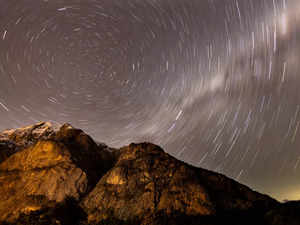 Reuters
ReutersDraconids Meteor Shower Lights Up the Evening Sky (October 8)
The first weekend of October will treat stargazers to the Draconids meteor shower, expected to peak after sunset on October 8. Unlike most meteor showers that typically grace the late-night sky, the Draconids are an exception, as they peak during the evening hours.
Although this meteor shower brings only around 10 meteors per hour, it has been known to surprise with occasional meteor storms, such as the one witnessed in 2018 when over 100 shooting stars graced the night sky. In 2011, an even more remarkable meteor storm displayed as many as 600 meteors per hour, although such an event is not anticipated this year.
"Ring of Fire" Eclipse: A Unique Celestial Display (October 14)
On October 14, a unique celestial alignment will occur, as the Sun, Moon, and Earth converge to create a solar eclipse. Unlike a total solar eclipse, where the Moon entirely obscures the sun, this event will be an annular solar eclipse. During this spectacle, a radiant halo of sunlight will surround the Moon, earning it the fitting nickname of a "ring of fire" eclipse. However, this unique display will only be visible within a narrow stretch from southern Oregon to southern Texas. The rest of North America will witness a partial solar eclipse.
Orionids Meteor Shower: A Shower of Shooting Stars (October 20-21)
Just under two weeks after the Draconids, sky enthusiasts can look forward to the Orionids meteor shower, gracing the night sky on October 20 and 21. This meteor shower promises approximately 20 shooting stars per hour. The meteors will appear to radiate from the same region as the constellation Orion, from which the shower gets its name. Some meteors may make their appearance in the evening, with hourly rates gradually increasing as the night progresses.
Partial Lunar Eclipse: A Spooky Nighttime Show (Final Weekend of October)
As October nears its end, a full Moon will illuminate the night sky during the final weekend. Alongside this lunar display, a partial lunar eclipse will unfold as the Moon partially enters Earth's shadow. While this celestial event will be best observed from Europe, Africa, and Asia, skywatchers in North America may miss out on this captivating lunar spectacle.
October promises to be a month filled with celestial wonder, offering stargazers an array of cosmic events to behold.

Read More News on
(Catch all the US News, UK News, Canada News, International Breaking News Events, and Latest News Updates on The Economic Times.)
Download The Economic Times News App to get Daily International News Updates.






 Get Unlimited Access to The Economic Times
Get Unlimited Access to The Economic Times

